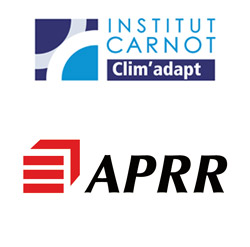A NEW SOLUTION FOR THE DIAGNOSIS OF EXTERNAL PRESTRESSING CABLES, I.E. SENSITIVE COMPONENTS OF LARGE BRIDGES MADE FROM PRESTRESSED CONCRETE
In partnership with the Société des Autoroutes-Paris-Rhin-Rhône (APRR) motorway company, Cerema tested a new method for the magnetic inspection of external prestressing cables, i.e. the steel elements that ensure the stability of the structures retained by their tensioning. Using a non-destructive method, this diagnosis served to identify cables that have defects due to corrosion.

The need
External prestressing cables run inside hollow concrete structures, called "voussoirs". In some architectural structures the walls of these voussoirs are openworked, which directly exposes the cables to inclement weather. Although the cables are in protective ducts, these can become damaged, and then the cables can become corroded and develop faults.
This is what happened to one of APRR's structures, to the point where a cable snapped in 2015. Following the break, the recommendation was to inspect the entirety of the cabling – total cumulative length 36 km – to identify whether other cables, as well as the broken one, had unseen faults within the ducts and would also have to be replaced.
The partnership
Cerema has a technological platform for characterisation of cables. Within this platform, the usage domain of magnetic cable inspection coils, which were initially designed for ski lifts, has been extended to include suspension bridges.
At APRR's request, the option of using this equipment on external prestressing cables was explored.
This method responds to the time-critical nature of the challenge, i.e. to anticipate the risk of further breakages and plan maintenance requirements. A traditional visual inspection, which involves cutting slots out of the duct in order to see the cable interior, would have taken about three years, without being exhaustive.
Using coils, the inspection can be conducted within 18 months, using a non-destructive method of detecting internal cable faults. For Cerema, the partnership offered an opportunity in terms of investing in this very expensive equipment, and new potential approaches for doing work on structures with external prestressing, such as major bridges on strategic routes.
The innovation
The method is based on magnetic inspection coils, with magnets that generate a magnetic field inside the cable. When the coil passes a defect, sensors detect magnetic flux leakage fields, which correlate with the loss of a steel section in the cable.
Following tests on some cables in suspension bridges, the method had to be adjusted and assessed in order to be suitable for inspecting external prestressing cables, which are composed of strands covered by a duct; the duct is injected with grout.
A preliminary phase of laboratory testing, on cable samples with known damage, served to validate the method.
Next, the method was adapted to the on-site work conditions. The main difficulty arose when passing the coils over the connecting sleeves between duct sections, which created a discontinuity that had to be corrected using a specially designed tube.

A partnership

Jean-Luc Dabert
Technical infrastructure advisor, APRR group
 Institut Carnot Clim’adapt is developing partnership-based research, i.e. management of research work conducted by public sector laboratories in partnership with socio-economic players, businesses of all sizes and local authorities, in order to meet their needs.
Institut Carnot Clim’adapt is developing partnership-based research, i.e. management of research work conducted by public sector laboratories in partnership with socio-economic players, businesses of all sizes and local authorities, in order to meet their needs.
By making use of Cerema’s exceptional resources and regional coverage relating to research, engineering, expertise and equipment, Clim’adapt supports its partners to enable them to transition to a resource-efficient, carbon-free, environment-friendly economy, linked to new life styles engendered by digital transition and adaptation to climate change.
Discover Institut Carnot Clim'adapt


